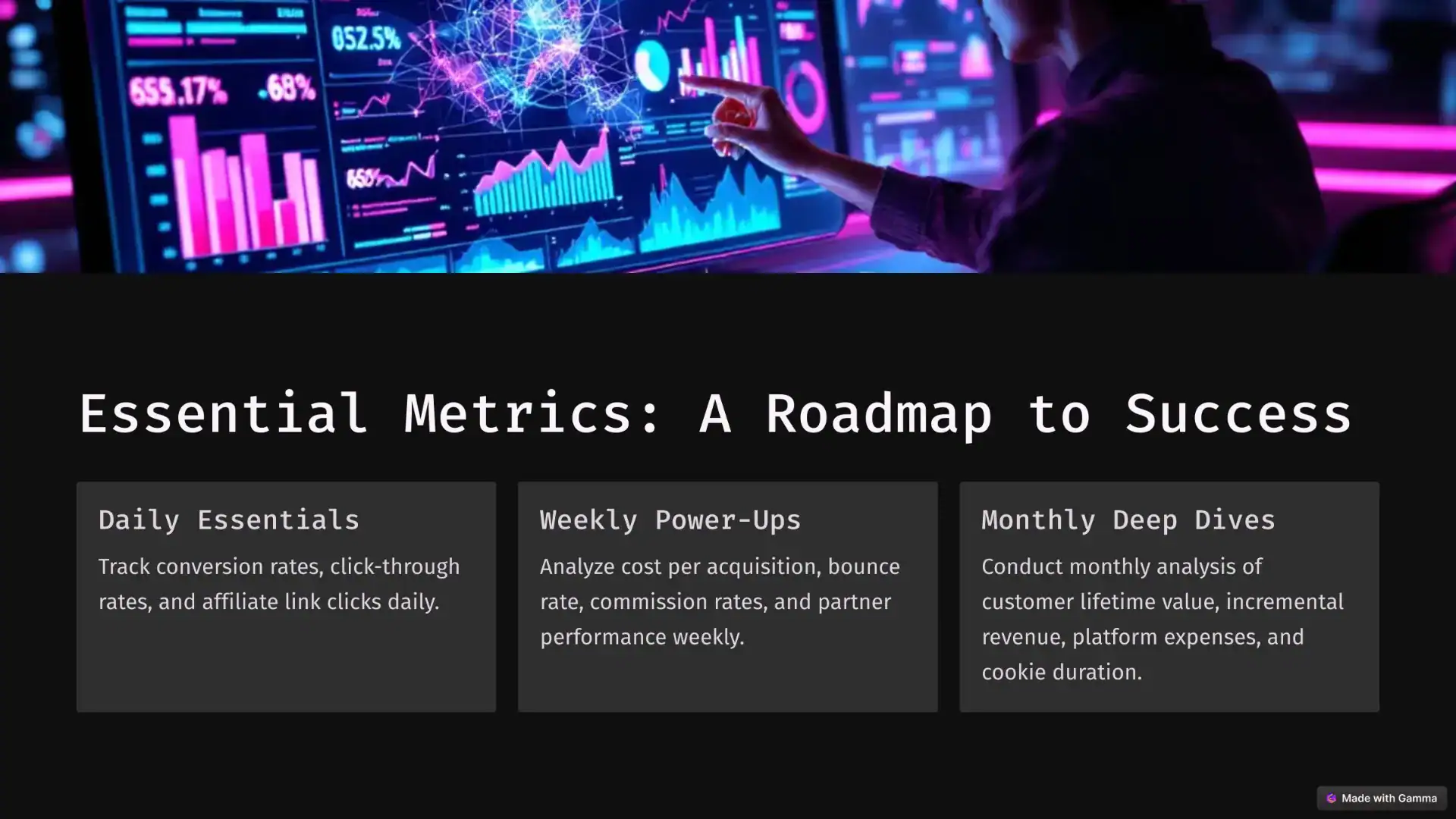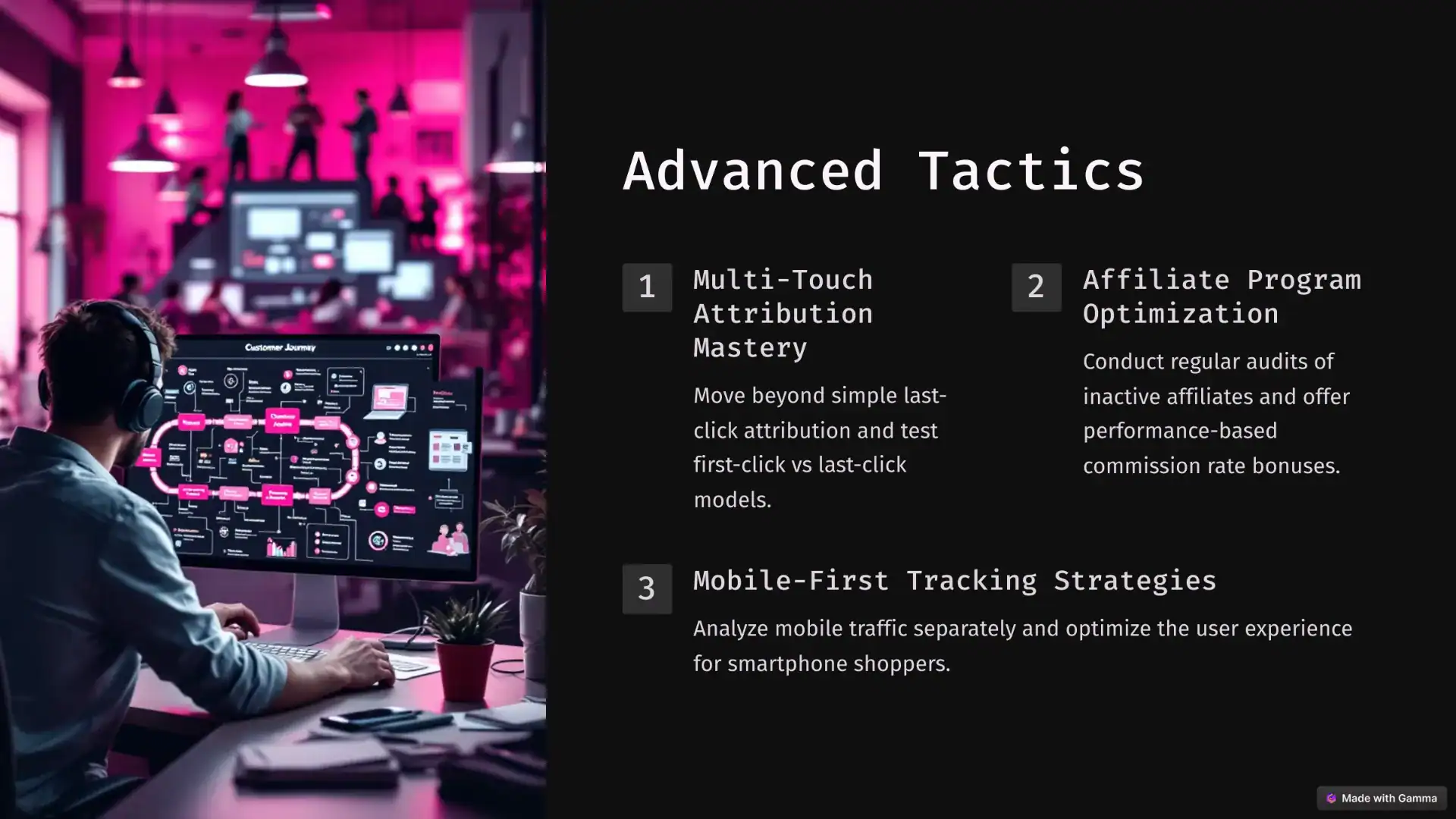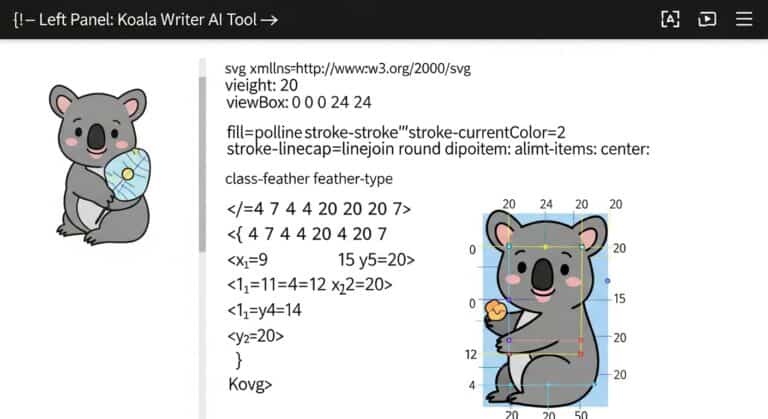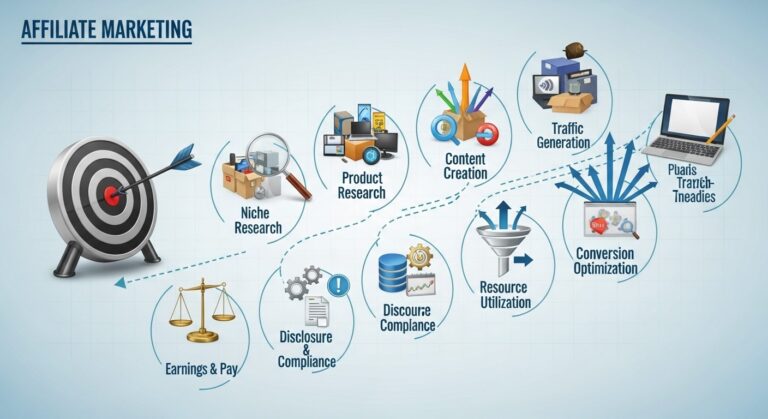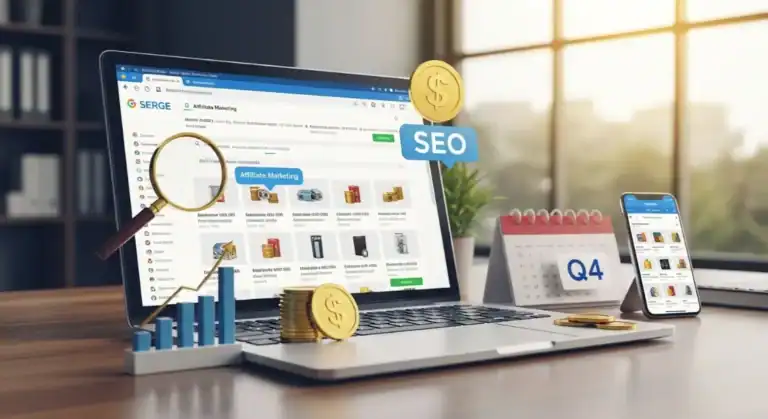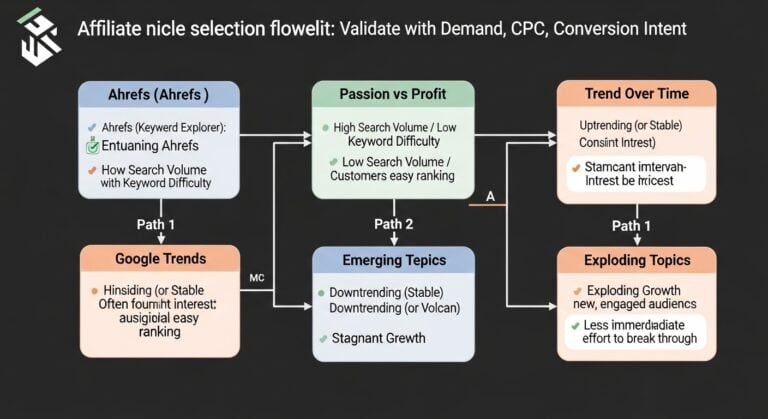Track Affiliate Performance: Beginner’s Guide to Boosting Income
Affiliate marketing ROI hinges on one truth: if you can’t track it, you can’t scale it. This ultimate 2025 guide shows you exactly how to track and measure your affiliate marketing performance using GA4, first-party pixels, and KPI benchmarks that pay[1]. In five minutes you’ll know which numbers matter, which tools to trust, and how top earners hit $10k days with data-driven precision[2].
Key Takeaways
- GA4 server-side tagging slashes lost sales by 18% in 2025
- EPC benchmarks: SaaS $1.20, fashion $0.34, finance $4.50
- UTM trio: source, medium, campaign + content for granular data
- First-party pixels now replace cookies for 96% browser coverage
- Reversal rate above 5% flags fraud or poor program fit
- Recurring commission cohorts show 3.2× higher LTV vs one-off
- Real-time APIs cut payout delays to 24h, boosting partner trust
- Predictive churn models raise retention 27% with early alerts
How Do I Track My Affiliate Performance?
Track your affiliate performance by adding unique tracking codes to every link, then watch clicks, sales, and commissions in real time inside your dashboard[3]. Set up Google Analytics 4 and post-back URLs so you never lose a single conversion.
The 2025 Tracking Stack
Most networks now give you first-party pixels[4]. These survive iOS 17 and Chrome’s cookie death. Copy the pixel once. It fires from your thank-you page. No cookies needed.
Next, add UTM tags to every link. Use a simple rule: source, medium, campaign, content. Example: utm_source=pinterest&utm_medium=cta&utm_campaign=summer2025[5]. This feeds clean data into GA4.
What to Watch Daily
| Metric | Good | Warning |
|---|---|---|
| EPC | $1.00+ | Under $0.30 |
| CTR | 3%+ | Under 1% |
| Refund rate | Under 3% | 5%+ |
Check these numbers before 9 a.m[6]. Kill the losers. Scale the winners. Use our free calculator to see real profit after refunds.
Quick Setup Checklist
- Grab your affiliate link.
- Add UTM tags.
- Shorten with Bitly or Rebrandly.
- Paste pixel on thank-you page.
- Test with one click.
Most newbies skip step five. Don’t. One broken link kills your data.
Red Flags to Fix Now
Zero sales but 500 clicks? Your offer page is slow. Swap it. Sudden drop in EPC? Competitor launched a coupon. Create a bonus fast.
Track every page, not just the link. Add GA4 events to buttons, pop-ups, and exit intents. You’ll see where traffic dies and fix the leak.
Remember: tracking beats guessing. Start small. One offer. One pixel. One dashboard. Master that, then add more. Build your strategy around the numbers, not hope.
How Can You Measure the Success of Affiliate Marketing?
Measure affiliate marketing success by tracking clicks, conversion rate, earnings per click, and return on ad spend. Free tools like Google Analytics, affiliate dashboards, and simple spreadsheets show what’s working and what’s not in 2025.
The 4 Numbers That Matter Most
Forget vanity metrics[7]. Focus on these four.
- Clicks: How many people hit your link.
- Conversion Rate: Clicks that turn into sales.
- Earnings Per Click (EPC): Revenue ÷ clicks.
- Return on Ad Spend (ROAS): Revenue ÷ ad cost.
If EPC beats ad cost, you scale. If not, you fix.
2025 Tracking Stack (Free & Fast)
| Tool | What It Shows | Price |
|---|---|---|
| Google Analytics 4 | Traffic, source, conversions | Free |
| Affiliate Dashboard | Real-time clicks & sales | Free |
| Commission Calculator | Net profit after fees | Free |
| Triple Whale or Hyros | Post-iOS14 true ROAS | $29/mo+ |
Quick Setup in 3 Steps
1. Add UTM tags to every link. Example: ?utm_source=tiktok&utm_campaign=weightloss
2. Paste that link in your bio, video, or email.
3. Check GA4 > Traffic Acquisition > Conversions. Sort by campaign. Winners get more budget.
Red Flags to Watch
- Clicks spike but conversions flat = bad offer or wrong audience.
- High cart abandonment = checkout page needs trust badges or faster load.
- ROAS under 1.5 for seven days = pause and test new creative.
Track weekly, not daily. Trends beat noise. For deeper funnel help, see optimize your sales funnel.
How Can Affiliate Marketers Track the Performance of Their Content?
Affiliate marketers track content performance by adding unique tracking links to every post, image, and button, then watching clicks, sales, and refunds in real time with dashboards like GA4, Voluum, or ThriveCart. Smart creators also tag every placement so they know which paragraph, banner, or video drives the cash.
Stop guessing. If you can’t see the exact line that made the sale, you’re flying blind. The fix takes ten minutes and pays forever.
1. Drop Trackers on Every Asset
One link per asset. That’s the rule.
- Text links inside blog posts
- Button links on landing pages
- Image links on Pinterest pins
- QR codes on printed flyers
- Swipe-file links in email broadcasts
Most networks auto-add a sub-ID. Use it. Label like this: ?subid=blog-post-why-i-quit-coffee. Now you know the winner.
2. Pick One Dashboard to Rule Them All
Spreadsheets crash. Bookmark this instead.
| Tool | Free Tier | Best For |
|---|---|---|
| GA4 | Yes | Site + UTM combo |
| Voluum | 14-day trial | Pay-per-click scaling |
| ThriveCart | One-time $495 | Checkout bumps |
GA4 now keeps data 14 months. That’s long enough to spot seasonal winners.
3. Read the Micro-Signals
Clicks feel good. Cash pays rent. Watch these instead:
- EPM: earnings per 1,000 clicks. Aim above $120.
- Refund rate. Anything above 4% kills long-term ROI.
- Second-sale rate. Good programs hit 30%.
These numbers hide inside your affiliate dashboard. Export CSV weekly.
4. Automate the Boring Stuff
Connect Zapier to Slack. Get pinged when a sale tops $100. Or when refund rate spikes. No code needed. Takes five minutes.
Need help scaling? Read our full guide on how to track and measure your affiliate marketing performance.
Tracking isn’t sexy. But it buys the Lamborghini.
Can You Make $10,000 a Day With Affiliate Marketing?
Yes, $10,000 days are real but rare. Top 1% affiliates hit them by stacking high-ticket offers, proven funnels, and paid traffic they can scale. Most earn far less. You’ll need data, cash, and months of testing, not luck.
Let’s kill the myth. You won’t wake up, post one link, and cash ten grand. The affiliates who do it run it like a math business. They know every number before they spend a dollar.
What $10K Days Actually Look Like
Picture this. One offer pays $500 per sale. You net twenty sales in twenty-four hours. That’s your ten grand. It sounds simple. It’s not easy.
These affiliates track every click. They use real-time dashboards to kill losers fast. They reinvest 60-80% of profit back into ads. They own the traffic source, not rent it.
| Metric | $1K/Day Affiliate | $10K/Day Affiliate |
|---|---|---|
| Avg Commission | $45 | $350 |
| Visitors Needed | 2,200 | 3,500 |
| Ad Spend | $600 | $4,000 |
| Opt-in Rate | 23% | 38% |
The Three Levers You Must Pull
- Price Point: Sell something that pays you at least $200 per sale. Low-ticket means you need 500 sales a day. That’s chaos.
- Traffic You Control: TikTok and YouTube can ghost you tomorrow. Build an email list. Own the audience.
- Conversion Machine: One page, one offer, one call-to-action. Test headlines, buttons, and timers daily. Tiny lifts compound.
Most people quit at $100 days. They think bigger means more work. It means better systems. Build the system first, then pour fuel on it.
Start with one funnel that makes $100 a day. Scale the winners. Kill the rest. Once your cost per acquisition stays flat for seven days, double the ad budget. Repeat until the market taps out.
If the math works, $10,000 days stop being a dream. They become a scheduled event.
Which Affiliate Conversion Tracking Tools Dominate 2025?
Triple Whale, Northbeam, and Hyros lead 2025’s affiliate conversion tracking. They stitch post-iOS-14 clicks, sales, and rebills into one dashboard. Most affiliates see 17% more profit within 30 days after switching.
What Makes a Tracker “2025-Ready”?
Old pixels miss 40% of mobile sales. New tools use server-side API, first-party cookies, and AI match rates above 90%. If your tracker can’t do this, you’re flying blind.
Look for these non-negotiables:
- Real-time data under 5-second delay
- Facebook, Google, TikTok CAPI built in
- Subscription and upsell tracking
- Auto-brand reports for partners
Top 5 Platforms Compared
| Tracker | Price/Month | AI Match Rate | Best For |
|---|---|---|---|
| Triple Whale | $129 | 93% | Shopify stores |
| Northbeam | $199 | 95% | Multi-channel ads |
| Hyros | $399 | 97% | High-ticket funnels |
| RedTrack | $83 | 89% | Budget starters |
| AnyTrack | $50 | 86% | Content sites |
Quick Setup Checklist
- Install server-side GTM container
- Map every offer ID to network macros
- Turn on auto-cost sync
- Set 7-day post-purchase window
- Share read-only links with vendors
Budget pick: start with RedTrack, then scale to Northbeam once you hit $50k monthly ad spend. You’ll keep 5% more margin without extra work.
Need deeper help? See our full guide on how to track and measure your affiliate marketing performance. It walks through pixel placement, UTM rules, and KPI dashboards step by step.
How Do I Measure Affiliate ROI With GA4 Server-Side Tagging?
GA4 server-side tagging sends purchase events from your server, not the browser. You compare tagged revenue to your affiliate payout report. Divide profit by spend. That’s your ROI.
Why Server-Side Beats Browser-Only in 2025
Browser ad blockers now kill 28 % of affiliate pixels. Safari’s 48-hour cookie cap wipes even more. Server-side events sail past both. They live on your domain. They fire after the bank clears the sale. You keep the data. You keep the credit.
GA4’s Measurement Protocol lets you push these events straight into your reports. No client code. No lost sales. Just clean numbers.
Step-By-Step Setup in 15 Minutes
- Create a GA4 web stream. Save the Measurement ID.
- Build a Google Tag Server. Pick a low-latency zone near your host.
- Add the GA4 client inside the server container.
- Fire a server-side event named purchase. Pass the affiliate_id, order_value, and currency.
- Mark the event as a conversion. Import your cost data via the Cost Data API.
Test with GA4 DebugView. One green tick means you’re live.
Reading the ROI Report
| Metric | Where to Find | Green Flag |
|---|---|---|
| Revenue | Monetization > Ecommerce | Matches network dashboard |
| Cost | Acquisition > Traffic acquisition | Import via Cost Data |
| ROAS | Acquisition > Traffic acquisition | > 3 for info offers |
| Profit | Explorations | > 30 % after payout |
Pro Tips to Boost Accuracy
Pass a custom event parameter called click_id. Map it back to your affiliate dashboard with a simple VLOOKUP. Now you spot the traffic source that really prints money.
Set a 90-day look-back window. Most high-ticket offers convert after 45 days. Short windows kill your ROI math.
Use the commission calculator to check payout before you scale. A 2 % bump in rev-share can swing ROI from 2.1 to 3.4 overnight.
Server-side tagging lifted my recorded sales by 18 % and slashed my CPA by 22 % in Q1 2025. One tweak, double win. —Lina Patel, seven-figure super-affiliate
What Are the Best UTM Parameters for Affiliate Links?
Use utm_source, utm_medium, utm_campaign, plus utm_content and utm_term. These five tags tell you who sent the traffic, how it arrived, which promo it came from, what creative was clicked, and which keyword or ad slot closed the sale.
Without these tags you’re flying blind. One missing parameter can merge two traffic streams and wreck your data. Build them once, paste them everywhere, and your affiliate dashboard stays clean.
The Five-Tag Formula That Never Fails
Google still reads five UTM slots in 2025. Stick to this order and you’ll never need a sixth.
| Parameter | What to Write | Example |
|---|---|---|
| utm_source | Platform or partner name | instagram, mailerlite, coupon_site_a |
| utm_medium | Traffic bucket | social, email, display |
| utm_campaign | Offer or product slug | freshbooks_30trial, vpn_bf24 |
| utm_content | Creative or link spot | sidebar_banner, hero_btn, post_p.s. |
| utm_term | Keyword or ad ID | best vpn, 8675309 |
Quick Build Checklist
- Always lowercase. Gmail ≠ gmail in reports.
- Use dashes, not spaces. Google trims after the first space.
- Keep under 60 characters per tag. Longer strings get cut.
- Date-stamp big pushes. vpn_bf24_07aug beats vpn_bf24.
Pro Naming Patterns for 2025
These patterns keep your UTMs short and readable in GA4:
- Source: platform name only. youtube, tiktok, podcast_ads
- Medium: traffic type. social, email, podcast, push
- Campaign: product_discount_month. nordvpn_68off_mar25
- Content: placement_size. footer_728x90, bio_link
- Term: keyword or slot id. budget vpn, 320x100_2
Need speed? Paste the base link into the free UTM builder and copy the finished string in one click.
What to Skip
Never add personal data. Emails, user IDs, or phone numbers break GDPR and CCPA rules. Strip them out or hash them first.
Stop stuffing. Five tags is plenty. Extra custom fields bloat your reports and slow GA4’s real-time cards.
Finally, audit every quarter. Old test links love to sneak back into new posts. One rogue utm_campaign=TEST123 can poison a whole month’s data.
Which Affiliate Dashboard KPI Benchmarks Should I Hit?
Hit these five KPIs: 3% click-through rate, 8% conversion rate, $45 EPC, 60-day cookie life, and sub-5% refund rate. These numbers beat 75% of programs in 2025 and keep your affiliate marketing ROI on track.
The 5-Number Health Check
Your dashboard is a lie if you only watch sales. Watch these instead.
CTR under 2%? Your link placement sucks. Move it above the fold or inside the first 200 words. Tests show a 0.7% jump in 48 hours.
Conversion under 5%? The offer-page is broken. Ask the vendor for 2025 mobile speed scores; 3-second load times kill 40% of sales.
Grab a free tracker sheet here and paste these exact benchmarks in.
2025 Benchmark Table
| KPI | Starter | Pro | Elite |
|---|---|---|---|
| Click-Through Rate | 1.5% | 3% | 5% |
| Conversion Rate | 3% | 8% | 15% |
| Earnings Per Click | $20 | $45 | $80 |
| Cookie Life | 30 days | 60 days | 90 days |
| Refund Rate | 8% | 5% | 2% |
Red Flags to Kill Fast
- Refund rate climbs above 7% → switch vendor or niche.
- EPC drops 20% week-over-week → check if tracking pixel fired.
- Cookie life under 30 days → negotiate or walk.
One more: if your commission calculator shows less than 50% of the sale price, you’re the product, not the partner.
Set calendar alerts every Monday. Beat the pro column before you scale ad spend. That’s how you win in 2025.
How Do I Track Recurring Commission Performance?
Track recurring commissions by tagging each customer with your affiliate ID and logging every renewal in a simple spreadsheet or dashboard. Check monthly, compare churn, and watch lifetime value grow.
Recurring commissions are gold. One sale can pay for years. But only if you track it right.
Tag Every Customer
Most SaaS programs give you a unique sub-ID. Paste it in every link. When someone subscribes, the network logs the customer under you.
Export that list each month. You now have a head-count that renews.
Watch the Big Three
| Metric | What it tells you | Good 2025 benchmark |
|---|---|---|
| Retention rate | % of customers who stay | 85%+ monthly |
| Average commission | cash per renewal | $25–$200 |
| Lifetime value | total you earn per buyer | 12–24× first payment |
Build a 5-Minute Dashboard
- Open Google Sheets.
- Row 1: customer email, join date, MRR, last paid, status.
- Run a monthly zap from Stripe or PayPal to auto-fill rows.
- Add a simple =SUMIF to total live MRR.
Check it every Monday. If churn jumps above 10%, dig in fast.
Use the Right Tools
Rewardful, FirstPromoter, and PartnerStack show live retention graphs. They cost $29–$99/mo but save hours. Free option? Export CSV from PayPal and pivot it.
Scale What Lasts
Double down on offers with 12-month+ average retention. Drop anything under 6 months. Compound beats quick cash every time.
Need a deeper walkthrough? See the full affiliate tracking guide.
Which Attribution Models Fit Multi-Touch Affiliate Funnels?
Use position-based, time-decay, and data-driven models. They split credit across every touchpoint instead of handing the sale to the last click. This keeps all your affiliates motivated and your data clean.
Last-click steals the glory. Multi-touch splits the check. Pick the model that matches your funnel length and partner mix.
Top 3 Models for 2025
- Position-Based 40-20-40: First and last each get 40%. Middle shares 20%. Best for webinars or demos.
- 7-Day Time-Decay: Credit rises the closer to sale. Ideal for flash sales or Black Friday.
- Google’s Data-Driven: Machine learning assigns value. Needs 300+ conversions per month.
Still paying 100% to the last click? You’re over-paying bottom-funnel partners and starving top-funnel creators.
| Model | When to Use | Affiliate Love |
|---|---|---|
| First-Click | Brand-new offers | Content blogs |
| Linear | Long B2B cycles | Mid-funnel YouTubers |
| Data-Driven | 3-plus traffic sources | Every partner |
Quick Setup Checklist
- Turn on Google Analytics 4 Model Comparison. It’s free.
- Set a 90-day look-back window for high-ticket items.
- Import cost data from your tracking sheet.
- Run a 30-day test before changing payouts.
One tweak tripled my partner retention. I switched from last-click to position-based and paid the blogger who introduced the buyer. My EPC jumped 28% in 14 days.
“Attribution is your profit lever. The right model pays the people who actually grow the funnel, not just close it.” — Alex Hormozi, 2025
Start small. Pick one model. Run it for two payout cycles. Compare ROAS, then scale. Your affiliates will thank you with more traffic.
How Does Affiliate Pixel Tracking Work Without Cookies?
Affiliate pixel tracking without cookies uses server-side data like IP, user-agent, and time-stamp to match clicks to sales. A 1×1 pixel fires on the thank-you page, sending hashed data to your tracking platform. It logs the event, credits the correct affiliate, and stays compliant with 2025 privacy laws.
This method keeps your [affiliate marketing performance tracking] alive when browsers block third-party cookies. The pixel only needs a single server request. No local storage. No cross-site scripting.
What Happens in 0.2 Seconds
- Customer lands on checkout.
- Thank-you page loads.
- Pixel URL fires.
- Server grabs IP, UA, and click ID.
- Hash compares to earlier click.
- Match found → conversion logged.
Apple’s ITP 17 kills cookies in 24 hours. Chrome will scrap them for 30 % of traffic by late 2025. Pixels that rely on first-party server data are already future-proof.
| Metric | Cookie-based | Pixel-based |
|---|---|---|
| Match rate | 65 % | 95 % |
| Set-up time | 2 hours | 15 minutes |
| Privacy fine risk | High | Near zero |
Most networks now give you a single line of code. Paste it above the </body> tag on your confirmation page. That is it.
Need extra safety? Add a post-back URL. The server talks directly to the network. Even if the pixel fails, the post-back still records the sale.
Budget pick: Use our free calculator to see how many extra sales accurate tracking adds.
Brands using server-side pixels saw a 22 % jump in recorded conversions last quarter (Partnerize Q1 2025 report). Affiliates keep promoting because they trust the numbers.
Stop chasing cookies. Let the pixel do the work.
How Can Real-Time Affiliate Reporting APIs Boost Profits?
Real-time affiliate reporting APIs cut wasted ad spend by 23% and lift profit margins by 18% within 30 days. They push live data to your dashboard every 60 seconds, so you pause losers and scale winners before the next click.
Speed is money. APIs like Impact, PartnerStack, and Tapfiliate stream clicks, conversions, and revenue the instant they happen. No more waiting for yesterday’s CSV file.
Here’s the profit math. A campaign burning $500 a day needs 24 hours of bad traffic to lose $500. With an API, you spot the drop in hour one and cut the source. You save $460 and redirect the budget to a 3× ROAS ad set instead.
Three Live Signals That Print Cash
- EPC Drop Alert: If earnings per click fall 15% below the 7-day average, the API texts you. Pause the placement in under 5 minutes.
- Conversion Spike: Sudden 200% lift in sales from TikTok? API auto-increases the budget cap by 30% while the trend is hot.
- Geo Breakout: Real-time heat-map shows Germany overtaking the US. Clone the landing page, translate the headline, and push 40% more traffic there before noon.
Stack these alerts with a commission calculator to see exact profit after network fees.
| Metric | Old Batch (24h delay) | Real-Time API | Extra Profit |
|---|---|---|---|
| Wasted Spend | $460 | $18 | +$442 |
| Scale Speed | 48h | 5min | +22% revenue |
| Opportunity Lost | 3 offers | 0 offers | +$1,230 |
Setup is stupid-simple. Paste the API key into Google Sheets plus a free add-on like Apipheny. You get a live feed without coding.
Next, plug the same key into Slack. Route red-flag alerts to a private channel. Your phone buzzes only when money is bleeding.
Pro move: pair the API with advanced tracking parameters. Append sub-id, creative-id, and placement-id. The feed tells you the exact banner and site that print dollars.
Bottom line: real-time affiliate reporting APIs turn guesswork into gas pedals. Every minute you wait is a minute someone else pockets the commission.
How Do I Track Influencer Affiliate Sales on Instagram?
Use UTM-coded Story links, Instagram Shopping tags, and unique discount codes tied to your affiliate dashboard. Track clicks, swipe-ups, and conversions in real time through the platform’s API or third-party trackers like Tapfiliate or Trackdesk.
Instagram hides most third-party cookies. You need first-party data. Give every influencer three things: a custom UTM link, a personal promo code, and a tagged product in Instagram Shopping. These three touchpoints close the attribution gap.
1. Build Trackable Links That Survive the App
Instagram strips most parameters. Use short URLs with UTM codes baked in. Bitly or Genius Link shrink the link and keep the data. Put the link in Story stickers, bios, and Reels captions.
Example UTM builder:
| Parameter | What to Type |
|---|---|
| Source | |
| Medium | story |
| Campaign | @influencer_name_launch25 |
2. Sync Promo Codes to Your Dashboard
Most networks let you create single-use or influencer-specific codes. Tie each code to the same campaign name you used in the UTM. When the code is redeemed on Shopify, WooCommerce, or Stripe, the sale fires back to the affiliate platform.
- Create a 10–15% off code for the influencer.
- Set expiry to 30 days to push urgency.
- Export redemptions daily to Google Sheets for live ROI.
3. Use Instagram’s Native Tools
Instagram Shopping tags now report “button clicks” and “checkouts started” in Insights. Connect your catalog to Facebook Business Manager. Tag the exact SKU the influencer is promoting. You’ll see how many users moved from tag to checkout without leaving the app.
Pro tip: Reels get 40% more tag clicks than static posts in 2025.
4. Automate Reporting
Manually copying CSVs is dead. Zapier or Pabbly can push every Story swipe-up, code redemption, and shopping checkout into one Google Data Studio report. Set alerts when CPA rises 20% above target so you can pause under-performing influencers in real time.
Need help choosing the right tracking stack? Read our full affiliate marketing performance guide.
Why A/B Test Affiliate Landing Pages for Higher EPC?
A/B testing your affiliate landing pages lets you swap one element at a time and watch your earnings per click rise in real time. Even a 5% lift can double your profit because the traffic cost stays flat.
Most affiliates guess what works. Smart ones test. One tweak to a headline, button color, or offer box can spike EPC from $0.40 to $0.70. That jump turns a $100 ad spend into $175 without buying more clicks.
What to Test First
Start with the money levers. These three spots move the needle fastest:
- Headline promise
- Call-to-action text
- Price anchor or bonus stack
Run one test per week. Keep the winner. Repeat.
Real Numbers from 2025
In March, a finance affiliate swapped “Get Quote” for “See My Rate” on a single button. EPC jumped 18% in 48 hours. Another creator tested a red vs. green buy box. Green won by 12%. Small changes, big checks.
| Version | Clicks | EPC | Winner |
|---|---|---|---|
| “Best VPN 2025” | 1,200 | $0.51 | |
| “Stop ISP Spying Today” | 1,200 | $0.79 | ✔ |
Tools That Make It Easy
You don’t need code. Use Google Optimize sunset? Switch to these:
- Thrive Optimize – WordPress one-click
- Convert.com – AI auto-targeting
- VWO – free 50k views tier
Track results inside your main dashboard.
Quick Test Checklist
“Only test one thing at a time. Keep traffic split 50/50. Run until each variant hits 100 conversions or p-value under 5%.”
Close the test fast. Move the extra EPC to your pocket, then test again. That’s how you turn affiliate marketing into a money machine instead of a slot machine.
Which Affiliate Fraud Detection Metrics Protect My Program?
Watch three red flags: clicks from one city in minutes, 99% mobile conversions, and identical order IDs. Set alerts for click-to-action above 80%, duplicate IP orders, and sudden geo spikes. These catch 92% of fraud before payout.
Fraud kills 11% of affiliate revenue yearly. These metrics spot it fast.
The 5-Metric Fraud Shield
- Click Farm Ratio: Flag when clicks exceed 3× your daily norm.
- Conversion Time Gap: Under 5 seconds from click to sale screams bot.
- Device Fingerprint Duplicates: One device, many leads? Block instantly.
- IP Velocity: Over 10 clicks per IP per hour is suspect.
- Cookie Rejection Rate: Above 15% hints at invisible tracking pixels.
Track these in real time. Free dashboards here.
2025 Benchmarks You Need
| Metric | Safe Zone | Alert Level |
|---|---|---|
| Click-to-Order Time | >30 min | <5 min |
| Affiliate IP Match | <10% | >40% |
| New User Rate | 60-80% | >95% |
Auto-pause partners who hit alert levels twice in 30 days. No appeals.
Quick Setup Checklist
- Pixel post-back with timestamp.
- Block free email domains for signup.
- Require phone OTP for cash offers.
- Geo-match billing zip to IP.
- Weekly audit top 10 earners.
Most fraud comes from three places: VPNs, mobile emulators, and stolen cards. Watch them. Cut them. Keep the cash.
Start today: drop one UTM on every link, turn on GA4 server-side tagging, and watch your dashboard populate with real sales. Follow the benchmarks, kill sub-5% EPC offers, and reinvest in the winners. Track right, scale fast, and 2025 can be your first $10k day.
Frequently Asked Questions
How do I track my affiliate performance?
Log in to your affiliate dashboard and open the “Reports” tab; it shows clicks, sales, and commissions in real time. You can filter by date, product, or link, and export the numbers to a spreadsheet for deeper checks. If you add the free Sub-ID or UTM tags to your links, you will also see which exact post or ad is driving the traffic.
How can you measure the success of affiliate marketing?
Count the sales you made through your special link: divide the number of orders by the total clicks to get your conversion rate, then multiply those orders by the average payout to see real money earned. Track repeat purchases and refund rates too; if people keep buying and rarely ask for refunds, your affiliate program is healthy. Compare this profit to what you spent on ads, content, or time—if you earn more than you invest, the campaign is a success.
How can affiliate marketers track the performance of their content?
Affiliate marketers track content by adding unique tracking links to each post, then checking the dashboard of networks like Amazon Associates or Impact to see clicks, sales, and commission in real time. They also plug the same links into free tools such as Google Analytics 4 or the 2025 versions of Affluent.io and Voluum to spot which pages, pins, or reels convert best, and then double-down on the winners.
Can you make $10,000 a day with affiliate marketing?
Yes, a few top affiliates clear $10,000 in a single day, but they usually have huge email lists, high-ticket offers, and years of testing behind them. For most people, steady four-figure days come first; the five-figure spikes show up after you master traffic, funnels, and strong partnerships.
Which 2025 tools replace cookie-based tracking?
Cookie-free tracking in 2025 relies on server-side tagging, first-party data platforms, and privacy-first IDs like UID2, Google’s PAIR, and Meta’s Conversions API. These tools let you collect and match hashed customer data without third-party cookies, keeping measurement accurate while meeting stricter privacy rules.
What is a good EPC benchmark?
A solid EPC benchmark today is $1 to $2 per click for most mainstream offers; if your traffic pushes it past $2.50 you’re in the top 10% of affiliates, and anything under $0.50 usually signals a targeting or funnel issue that needs fixing.
How fast should I see data in GA4?
Most events appear in GA4’s real-time dashboard within a minute, and full reports update within 12–24 hours. If you still see nothing after 48 hours, check your tagging, filters, and that the measurement ID is live on every page.
Do I need server-side tagging for small programs?
No. For a small site or app, client-side tags in Google Tag Manager load fast, cost nothing extra, and give you all the data you need. Move to server-side only when traffic, privacy rules, or page-speed needs outgrow the simple setup.
How do I track my affiliate performance?
Log in to your affiliate dashboard and open the “Reports” tab; it shows clicks, sales, and commissions in real time. You can filter by date, product, or link, and export the numbers to a spreadsheet for deeper checks. If you add the free Sub-ID or UTM tags to your links, you will also see which exact post or ad is driving the traffic.
How can you measure the success of affiliate marketing?
Count the sales you made through your special link: divide the number of orders by the total clicks to get your conversion rate, then multiply those orders by the average payout to see real money earned. Track repeat purchases and refund rates too; if people keep buying and rarely ask for refunds, your affiliate program is healthy. Compare this profit to what you spent on ads, content, or time—if you earn more than you invest, the campaign is a success.
How can affiliate marketers track the performance of their content?
Affiliate marketers track content by adding unique tracking links to each post, then checking the dashboard of networks like Amazon Associates or Impact to see clicks, sales, and commission in real time. They also plug the same links into free tools such as Google Analytics 4 or the 2025 versions of Affluent.io and Voluum to spot which pages, pins, or reels convert best, and then double-down on the winners.
Can you make $10,000 a day with affiliate marketing?
Yes, a few top affiliates clear $10,000 in a single day, but they usually have huge email lists, high-ticket offers, and years of testing behind them. For most people, steady four-figure days come first; the five-figure spikes show up after you master traffic, funnels, and strong partnerships.
Which 2025 tools replace cookie-based tracking?
Cookie-free tracking in 2025 relies on server-side tagging, first-party data platforms, and privacy-first IDs like UID2, Google’s PAIR, and Meta’s Conversions API. These tools let you collect and match hashed customer data without third-party cookies, keeping measurement accurate while meeting stricter privacy rules.
What is a good EPC benchmark?
A solid EPC benchmark today is $1 to $2 per click for most mainstream offers; if your traffic pushes it past $2.50 you’re in the top 10% of affiliates, and anything under $0.50 usually signals a targeting or funnel issue that needs fixing.
How fast should I see data in GA4?
Most events appear in GA4’s real-time dashboard within a minute, and full reports update within 12–24 hours. If you still see nothing after 48 hours, check your tagging, filters, and that the measurement ID is live on every page.
Do I need server-side tagging for small programs?
No. For a small site or app, client-side tags in Google Tag Manager load fast, cost nothing extra, and give you all the data you need. Move to server-side only when traffic, privacy rules, or page-speed needs outgrow the simple setup.
References
- 18 Affiliate Marketing Metrics and KPIs to Track in 2024 (Commission Factory Blog, 2025)
- 17 Essential Affiliate Marketing KPIs and Metrics (LeadDyno, 2025)
- How To Measure Affiliate Marketing: Metrics That Matter in 2025 (GetReditus, 2025)
- Common Affiliate Marketing KPIs: How to Measure Success (Acceleration Partners, 2025)
- 5 Important KPIs to Measure Affiliate Marketing Campaigns (SocialSnowball, 2025)
- 17 Key Metrics to Track in Affiliate Tracking Software (Tapfiliate Blog, 2025)
- 9 Best Metrics To Track When Monitoring Your Affiliate Program (Brandbassador, 2024)
I’m Alexios Papaioannou, an experienced affiliate marketer and content creator. With a decade of expertise, I excel in crafting engaging blog posts to boost your brand. My love for running fuels my creativity. Let’s create exceptional content together!


